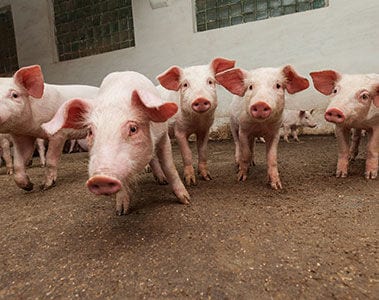
-
Global/EN
- Global
- North America
- Latin America
Drought and high temperatures continue to plague the Northwest of the United States and Western Canada. The feed industry in these areas can expect to see lower quality wheat at discount prices. Drought and high temperatures increase the amount of protein and arabinoxylans in wheat while B-Glucan content declines (Rakszegi et al., 2013). Although drought negatively affects bushel weight, this is a poor indicator of dietary energy for pigs and poultry (Wiseman, 2000).
The combined effect of maximizing wheat inclusion rates with higher arabinoxylan content of drought-affected wheat calls for a review of the enzymes in your feed. RONOZYME® MultiGrain provides not only the xylanase but debranching enzymes as well. While wheat arabinoxylans are not as heavily branched as those in corn, debranching enzymes can facilitate the breakdown of the xylan backbone in wheat (Lei et al., 2016). Furthermore, they break the link between arabinoxylans and phenolic compounds in the cell walls to help release entrapped nutrients for digestion.
Moreover, although drought-stricken wheat contains higher protein content, this occurs at the expense of most of the essential amino acids (Moral et al., 2007). Drought favors an increase in gliadin proteins to the detriment of albumins and glubulins, the latter being high in several important essential amino acids. Therefore, formulating diets with drought-affected wheat with higher protein inadvertently increases the protein content of poultry diets. Arginine is the fourth limiting amino acids in wheat-based broiler diets (after methionine, lysine, and threonine), so limiting the ration’s increase in protein using more of the synthetics will not be possible until synthetic L-arginine becomes economical to use. The use of exogenous proteases such as RONOZYME® ProAct can limit the rise in protein while maximizing the use of drought-affected wheat and making amino acids such as arginine more available.
21 November 2021
Nelson is an Enzyme Lead All Species, North America. He holds a PhD obtained at Clemson University.
Nelson held positions in technical service and technical marketing for enzymes, vitamins, and HyD within DSM. His expertise extends to growth promotants and amino acids from previous engagements. He currently is an adjunct professor at two universities in the U.S.
Doug Teitge is a senior technical support manager. He received his MSc in poultry nutrition from the University of Saskatchewan. Before joining DSM, Doug served as a monogastric nutritionist. He has more than 30 years of feed industry experience.
We detected that you are visitng this page from United States. Therefore we are redirecting you to the localized version.